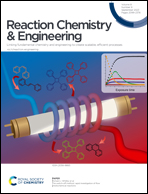Rare-earth doped hexagonal NaYbF4 nanoprobes with size-controlled and NIR-II emission for multifunctional applications†
Abstract
Hexagonal NaYbF4-based fluorescent nanoparticles are widely used in near-infrared bioimaging, especially in the second near-infrared (NIR-II) window region, which has obvious advantages in imaging depth and contrast. In this region, the autofluorescence of biological tissues and the absorption and scattering of photons by tissues are significantly weakened. However, there are still many difficulties in controlling the size, morphology, crystalline phase, and monodispersity of such nanomaterials. In this study, we selected Tm3+ with characteristic emission at 1470 nm as the activation center, hexagonal NaYbF4 as the main body, and produced controllable NaYbF4:Tm3+ nanoparticles by the thermal decomposition method. In addition, we found that the cubic NaYbF4:Tm3+ nanoparticles with irregular shapes can be transformed into highly monodisperse hexagonal NaYbF4:Tm3+,Gd3+ nanoparticles by doping appropriate concentrations of Gd3+. At the same time, Yb3+ in the nucleus can increase the absorption cross-section at 980 nm and thus enhance the fluorescence emission of Tm3+. Ce3+ can inhibit the upconversion pathway of Tm3+ and thus enhance the downshifting emission at 1470 nm. Then, we epitaxially grew a layer of NaYF4 inert shell with certain biocompatibility on the hexagonal nanoparticle core to suppress the surface-related quenching mechanism, which can significantly improve the downshifting efficiency of NaYbF4:Tm3+,Gd3+,Ce3+. Finally, we used distearoyl phosphatidylethanolamine-polyethylene glycol (DSPE-mPEG2000) to modify the surface of NaYbF4:Tm3+,Gd3+,Ce3+@NaYF4 core–shell nanocrystals to make them highly biocompatible for bioimaging and magnetic resonance imaging (MRI).



 Please wait while we load your content...
Please wait while we load your content...